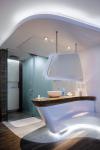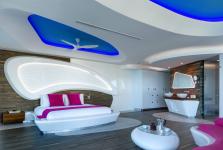Design Concept inspired by the Coral Reef of the Caribbean Sea
Exotic, sustainable and avant-garde design, inspired by the coral reef of the Caribbean Sea. The design concept is focused on representing an experience for each of its visitors through a natural, unique and contemporary environment.
Modular structure and high thermal efficiency
The structure of the building is totally regulated through the constructive system based on frames, which makes a logical, simple and economical structure. The entire building uses the Novidesa construction system (high density polyurethane), which is highly efficient in thermal and acoustic insulation.
Functionality and a view from every room
This project’s first principle, which is functionality, was resolved by best utilizing the space. Secondly, since the site offered a short façade overlooking the sea and a long façade facing the street, the solution was to rotate the building 30 degrees to ensure all rooms featured an ocean-view. The project was developed across three levels of rooms, in addition to the following on each level: a basement level with utilities, a ground floor with reception and a restaurant, and a roof pool on the third level.
Sustainable Concept
High Efficiency with Low Energy Consumption
The whole building is built using a high density polyurethane construction system, which prevents solar radiation heating, and integrates double glazed windows, achieving a completely isolated system when the use of air conditioning is required. The design features a highly efficient use of cross ventilation of natural air which keeps the consumption of air conditioner to the very minimum. In addition, the heat emitted works to heat the water.
The water system is divided into sewage and gray, independently treated. In terms of lighting, the entire building has LED technology with low energy consumption.
2016
2017
Climate Analysis
The hotel is located on one of the most paradisiacal beaches of the Caribbean Sea, on Calle 8 in Playa del Cármen, Quintana Roo. The climate of the region is warm and sub-humid. The movements and angles of the sun were analyzed with solar geometry, which allowed us to implement effective architectural shading elements. Overhangs and lattices were put in place to prevent the penetration of direct sunlight into the interiors and to block the South and West facades.
Sundown
The average annual temperature ranges between 28º C and 32º C (82º F and 90º F) in summer; and from 26º C to 27º C (78º F and 80º F) in winter. Isolating the building was essential to create comfortable interior temperatures. The thermal gain that the building would undergo was calculated using a thermal digital analytical model, obtaining a greater gain in the roofs, South and West façades, all of which dictate the choice of materials.
Energy Savings
The building is conditioned to reduce energy consumption by the efficient design of constructive, hydraulic, electrical, electronic and refrigeration systems, which have a fundamental role in the energy efficiency of the building.
The 100% of the building is made with state-of-the-art LED luminaires with the highest energy efficiency of very low consumption.
The use of efficient refrigeration equipment reduced CO2 emissions by 30%.
The energy consumption of the building is reduced due to the care in the choice of all its systems, which leads to a saving in its consumption and a reduction of the pollution during its life cycle.
Each room has presence detectors and door and window opening sensors in order to reduce and control the air conditioning system and avoid waste of energy.
Innovative Materials
To avoid the passage of heat through thermal conductivity to spaces, innovative materials were used. The entire building, both its slabs, exterior and interior walls were made with high density polystyrene insulation materials. All windows are made of triple-pane glass with argon gas with very low thermal conductivity.
Cross-Ventilation
Knowing that the dominant winds in the Caribbean come from the Southeast and East, it was decided to turn the rooms 30 degrees to capture the wind and extract it through a duct in the ceiling of the corridor, creating natural ventilation in each space.
User experience through art
Having solved the principles of utility and logic, we then focused on aesthetics. After analyzing the context, we concluded that because of the hotel’s location on the coast of Playa del Carmen, and the extensive number of competing hotels in the same prince range, the only way to stand out against the competition was to create a boutique hotel that gives added value to the client. In this case, the added value is a building that offers a relaxing experience, in harmony with nature, art and elegance for each of its users. The primary objective of the client is to compete commercially with quality offering a sustainable, unique and iconic product in the area.
Concept Design and Project: sanzpont [arquitectura]
Project Team: Victor y Sergio Sanz Pont, Elizabeth Valencia, Eder Hernández, Valeria Gómez H., José Rodríguez, Sophia Martínez, Eric Gallegos, Mauricio Duhart, Osvaldo Cámara, Johan Velazco, Melissa Chavez, Uriel Mena, Ana Cristina Avilés, Montserrat Palau, Ali Jossafat.
Construction Team:
Architectural Supervision: sanzpont [arquitectura]
Brickworks and Finishes: Épica
Facilities: Arbibe
Carpentry: DCM
Structural Calculation: Macrosteel
Structure Materials:
Metallic structure:
High Density Extruded Panel (Novidesa) in walls and slabs
Triple Glass with Argon Gas in windows
Decoration: sanzpont [arquitectura] + Arbibe
Lighting: sanzpont [arquitectura] + Arbibe
Interior design: sanzpont [arquitectura] + Arbibe
Photographer: Santiago Heyser
















